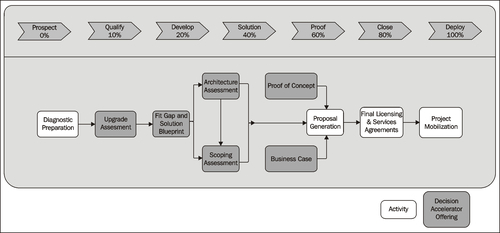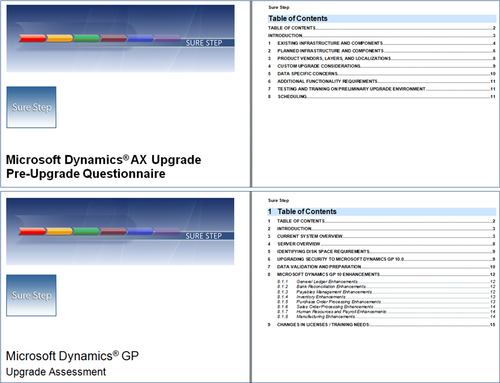The Diagnostic phase also supports the process for selling
solutions to an existing customer, which is the topic of discussion in
this section.
The following diagram shows
the flow of activities and Decision Accelerator offerings for an
existing customer. The flow is very similar to the one for a prospect,
with the only difference being the Upgrade Assessment DA offering
replacing the Requirements and Process Review DA.

Much like the flow for a
prospect, the flow for the existing customer begins with the Diagnostic
Preparation. In this case, however, the sales team uses the guidance to
explain the capabilities and features of the new version of the
corresponding Microsoft Dynamics solution. When the customer expresses
interest in moving their existing solution to the current version of the
solution, the next step is the Upgrade Assessment DA offering.
Assessing the upgrade requirements
The services delivery team has
two primary objectives when conducting the Upgrade Assessment DA. First,
the delivery team assesses the current solution to determine the impact
of the proposed upgrade. Second, they determine the optimal approach to
upgrade the solution to the current version.
The Upgrade Assessment DA
begins with the solution delivery team meeting with the customer, to
understand the requirements for the upgrade. The solution delivery team
is usually comprised of solution and/or service sales executives, as
well as solution architects and senior application consultants to
provide real-life perspectives to the customer.
Sure Step provides
product-specific questionnaires that can be leveraged for the Upgrade
Assessment exercise. The following screenshot shows two examples of the
table of contents of these upgrade questionnaires—one for Microsoft
Dynamics AX and the other for Microsoft Dynamics GP:

In the next
step, the solution architect and/or application consultants review the
configurations, customizations, integrations, physical infrastructure,
and system architecture of the customer's existing solution. The team
then proceeds to highlight those requirements that can be met by the new
feature enhancements, and determine if there are any customizations
that may no longer be necessary in the new product version. The team
also reviews the customizations that will need to be promoted to the
upgraded solution, and identifies any associated complexities and risks
involved in upgrading the solution. Finally, the team will clearly
delineate those requirements that require the implementation of new
functionality. For the new functionality, the delivery team can avail of
the corresponding product questionnaires from the Requirements and
Process Review DA offering.
The last step in the Upgrade
Assessment DA offering is to agree upon the delivery approach for the
upgrade. If no new functionality is deemed necessary as part of the
upgrade, the solution can use the Technical Upgrade project type
guidance, workflow, and templates. On the other hand, if a new
functionality is deemed necessary, it is recommended to use a phased
approach in which the first release is a Technical Upgrade to bring the
solution to the current product version, then the ensuing release or
releases implement the new functionality using the other Sure Step
project types (Rapid, Standard, Enterprise, or Agile).
Applying the other Decision Accelerators on upgrade engagements
If the upgrade is strictly
to promote the solution to a current, supported release of the product,
the solution delivery team can skip the Fit Gap and Solution Blueprint
exercise and go to the Architecture Assessment DA offering to determine
the new hardware and infrastructure requirements, and the Scoping
Assessment DA offering to estimate the effort for the upgrade. The team
may also choose to combine all these offerings, and just use the
templates and tools from the other offerings to provide the final report
and estimates to the customer.
If the upgrade is going to
introduce a new functionality, depending on the magnitude of the new
requirements, the customer and sales teams may deem it necessary to
execute or combine the Fit Gap and Solution Blueprint, Architecture
Assessment, and Scoping Assessment DA offerings. This ensures that a
proper blueprint, system architecture, and overall release approach is
collectively discussed and agreed upon by both parties.
In both cases, the Proof of
Concept DA and Business Case DA offerings may not be necessary, although
depending on the scope of the new functionality being introduced in the
upgrade, the customer and sales teams may decide to use the Business
Case tools to ensure that the project justification is established.
After
the completion of the necessary DA offerings, the sales team can then
proceed to the Proposal Generation activity to establish the Project
Charter and Project Plan. The next step is then to complete the sale in
the Final Licensing and Services Agreement activity, including agreeing
upon the new terms of the product licenses and the Statement of Work for
the solution upgrade. Finally, the delivery team is mobilized in the
Project Mobilization activity, to ensure that the upgrade engagement is
kicked off smoothly.